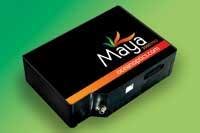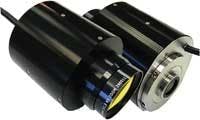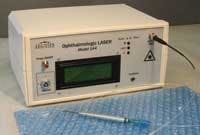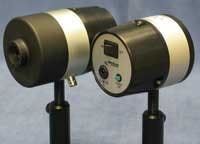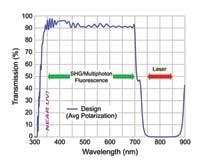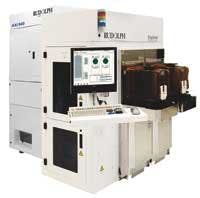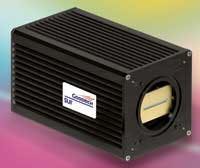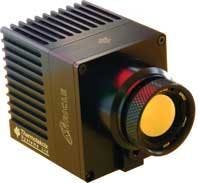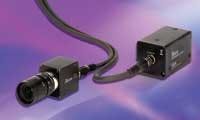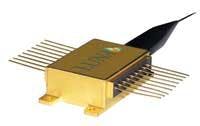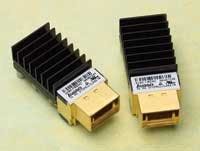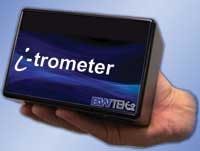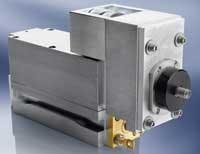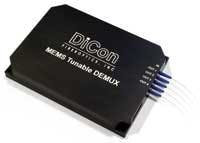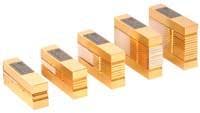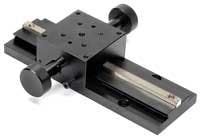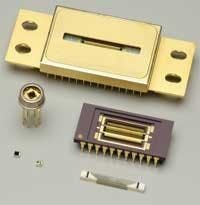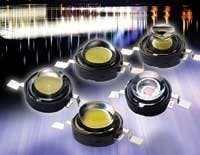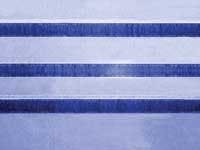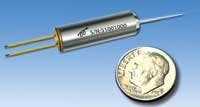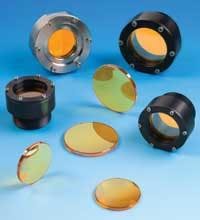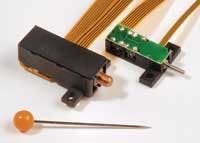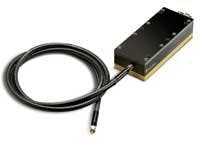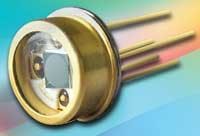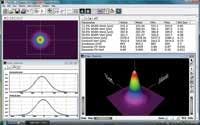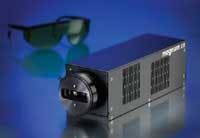FFT-CCD spectrometers
The Maya2000 series back-thinned 2-D FFT-CCD spectrometers are designed for low-light-level, UV-sensitive applications such as fluorescence, DNA sequencing, and Raman analysis. The Maya2000 and Maya2000 Pro offer better than 90% quantum efficiency, a USB 2.0 interface, low-noise electronics, and 14 grating options.
Ocean Optics, Dunedin, FL
www.oceanoptics.com
CCTV zoom lens
The Model 290 motorized nonbrowning CCTV zoom lens uses glass that withstands long-term exposure up to a total of 100 million rads of radiation and 55ºC without discoloration. The compact, 6× optical-tracking zoom operates at f/1.8 and is used with single-chip 1/2 in. and 2/3 in. CCTV cameras in environments subject to radiation, such as nuclear power plants.
Resolve Optics, Bucks, England
[email protected]
Fiber-coupled laser
The SL 1.4 fiber-coupled laser is designed specifically for surgical applications in the ophthalmic market. An alternative to holmium lasers, it has a 1.4 µm laser line, which matches the absorption spectrum of water in the cornea, and is suited for laser thermal keratoplasty.
Zecotek, Vancouver, Canada
[email protected]
Digital radiometers and joulemeters
The TRAP series of digital radiometers and joulemeters have measurement uncertainty of less than 1%. The TRAP, developed at NIST, is a large-area black pyroelectric detector opposite a large-area broadband mirror in a 15º wedge configuration. The wedge is designed so that 99% of the light passing through the 5 mm aperture is absorbed and measured. The spectral response from 0.25 to 15 µm is flat to 1% or better.
Spectrum Detector, Lake Oswego, OR
[email protected]
Raman edge filters
The E-grade line of RazorEdge thin-film optical edge filters for Raman spectroscopy make possible measurements of Stokes-shifter Raman signals close to the laser line. The filters for 532, 633, and 785 nm lasers have an edge steepness of 0.2% of laser wavelength, measured from optical density 6% to 50% transmission. That equals 1 nm or approximately 40 cm1 for a 532 nm edge filter.
Semrock, Rochester, NY
[email protected]
Defect-inspection module
The AXi 940 macro defect-inspection module performs wafer front-side inspection as part of the all-surface Explorer Inspection Cluster. It contains intelligent software that automates many tasks and decisions about recipe creation normally done by a tool operator.
Rudolph Technologies,
Flanders, NJ
www.rudolphtech.com
NIR camera
The SU-LDH digital-line-scan near-infrared InGaAs camera has a line rate of more than 46,000 lines/s for 1024 pixels, useful for Fourier-domain optical coherence tomography. It provides wavelength response from 0.8 to 1.7 µm, suitable for high-data-rate industrial process control and machine vision. It allows room-temperature-stabilized operation and integrate-while-read capability.
Sensors Unlimited, Goodrich, Princeton, NJ
[email protected]
Thermal-imaging camera
The Miracle 100K-25 thermal-imaging camera uses a 384 × 288 uncooled microbolometer focal-plane-array detector and is sensitive in the 7 to 14 µm band. It operates without thermoelectric stabilization and is also available in a shutterless model for instant-on imaging. It has a 25 µm pitch, sensitivity of better than 60 mK at 27ºC, and response time of 7 ms.
Thermoteknix Systems,
Waterbeach, Cambridge, England
[email protected]
CCD camera
The IK-TF9H9U color camera features a remote head measuring 32.6 × 38.6 × 41 mm that outputs 2048 × 1536 pixels. It comes with CameraLink output, a C-mount, and two optional cable lengths of 3 or 5 m. It is based on 3CCD prism block technology and offers rates of up to 20 frames/s, or 50 frames/s in partial scan mode.
Toshiba Imaging Systems Division, Irvine, CA
www.cameras.toshiba.com
Fiber laser
The Perseus-TS pulsed fiber laser has been optimized for integration into LADAR systems. It comes in two models, each producing 2 to 6 ns pulses of 1.54 µm light at rates from 20 to 750 kHz, with 2 or 4 W average power. Maximum pulse energy is 60 µJ. Peak power is 20 kW. Custom configurations are available.
Aculight, Bothell, WA
[email protected]
Tunable laser
The Pheonix 1000 tunable laser is a MEMS-based, external-cavity laser designed for measurement, fiber-grating-based sensing, spectroscopy, and metrology. The miniaturized, 18-pin TEC-cooled package includes tuning up to 500 Hz, mode-hop-free swept operation over the C-band from 1515 to 1565 nm, and a linewidth of less than 2 MHz.
Luna Innovations, Roanoke, VA
www.lunatechnologies.com
Laser-diode controller
The Vue-MV-40 laser-diode controller is designed for applications that use 15 to 20 discrete laser diodes operated in series, such as fiber lasers and amplifiers, materials processing, and medical systems. It includes DiodeGuard diode protection circuitry. It is available in 40V, 10A and 27V, 15A configurations.
VueMetrix, Sunnyvale, CA
[email protected]
Optical modules
The AFBR-776/786BxxZ 12-channel parallel optic modules provide 6.25 Gbit/s per channel for an aggregate of 75 Gbit/s per link (up to 100 m). The devices include two-wire serial-interface monitoring capabilities for expanded per channel functionality and programmability.
Avago Technologies, San Jose, CA
www.avagotech.com
Pump-laser combiner
ITF Laboratory’s end-coupled fiber-based combiners have passed all Telcordia GR-1221-CORE qualification requirements. The devices increase laser power by combining more than 1 kW of pump power in a single combiner. Using an all-fiber design, the input power remains in the fiber for low insertion loss, low polarization-dependent loss, and high power-handling capability.
Avensys, Montreal, Canada
www.avensyscorporation.com
CCD array spectrometers
CCD array spectrometers in the i-trometer series have a high UV-NIR response, wide dynamic range, and a back-thinned CCD array with a 0.22 NA optical bench. A uniquely keyed SMA905 fiber-connector option is designed for ease of repeatable fiber coupling. Plug-and-play USB interface and high-speed data transfer are provided.
B&W Tek, Newark, DE
www.bwtek.com
Tunable SFF transponder
The TL9000 is a Telcordia-qualified tunable 300-pin small-form-factor transponder (TSFF). It has a 2.2 × 3 in. footprint, allowing network equipment manufacturers to increase port density, placing two SFF transponders on a card where only one LFF would fit. This device is a direct drop-in replacement for the LFF devices.
Bookham, San Jose, CA
[email protected]
Picosecond fiber laser
A 10 GHz picosecond fiber laser features automatic modelocking, a C-band, 1.0 µm, 780 nm wavelength, and is tunable from 0.8 to 10 ps pulsewidth. It has a 0.4 to 43 GHz repetition rate, low timing jitter of less than 23 fs, average output power of more than 20 mW, low RF input of 0 dBm, and is polarization maintaining.
Calmar Optcom, Sunnyvale, CA
[email protected]
Vision sensor
The Checker 232 vision sensor is designed to inspect small features over a wide area. The sensor is designed to work on rapid production lines, detecting and inspecting up to 1500 parts per minute. It uses patent-pending multi-image analysis to determine whether a part is present without an external trigger and can track parts in varying positions along the production line.
Cognex, Natick, MA
www.cognex.com
Fiber-Bragg-grating components
The Power Spectrum product line includes fiber-Bragg-grating components for incorporation into fiber and semiconductor lasers used in industrial, military, and aerospace markets. The PowerSpectrum-HPR is a high-power reflector for CW or pulsed lasers up to 800 W. The PowerSpectrum-NLS is a narrowband laser stablilizer, athermally packaged with standard or polarization-maintaining fiber.
TeraXion, Quebec City, Canada
[email protected]
Optically pumped semiconductor lasers
The OPSL-532-5 is a 5 W green laser with an output at 532 nm and the OPSL-577-3 delivers 3 W of yellow output at 577 nm. The yellow output is exactly matched to the main absorption peak of oxygenated hemoglobin and provides a higher degree of tissue selectivity. Patented OPSL technology utilizes a compact, monolithic architecture, operating at any arbitrary VIS or NIR wavelength and output power and has pulses as short as 10 µs.
Coherent, Santa Clara, CA
[email protected]
Triplexer transceiver
The GEPON (EPON) PX10 Triplexer transceiver for the FTTH market has digital receiver sensitivity at a minimum of 26.5 dBm and a video PIN-based receiver optimized for reception of up to 870 MHz analog video signals with minimal CNR of 46 dB. The transceivers are based on the proprietary SystemOnGlass concept in which an additional video overlay channel is integrated into the PLC chip.
ColorChip, Caesarea, Israel
www.color-chip.com
MEMS-tunable demux
The MEMS-tunable demux module allows network operators to select and drop any combination of four (or eight) channels from the network. The module is housed in a 125 × 90 × 16 mm form factor and offers faster than 30 ms tuning speed, better than +30 pm wavelength-setting accuracy, and a 0.2 nm 100 GHz passband (0.12 nm for 50 GHz). It is available with both 50 and 100 GHz channel spacing, in four- and eight-channel configurations.
DiCon Fiberoptics, Richmond, CA
[email protected]
Diode-laser arrays
A series of high-power, water-cooled diode-laser arrays are used in scalable stack designs that deliver up to 80 W CW power bar at standard wavelengths of 808, 940, and 980 nm. Designed for industrial applications, the stack designs are available up to 12 bars horizontally side-by-side or up to 70 bars vertically stacked.
DILAS Diode Laser, Tucson, AZ
[email protected]
40 Gbit/s receivers
New product variants join the 40 Gbit/s photodiode and receiver line for ASK, DPSK and DQPSK modulation formats. They have GPPO style differential RF outputs and use an InGaAs photodiode chip with module packaging. Receiver configurations include single, balanced, and dual detection schemes, with and without transimpedance amplification. Up to 13 dBm optical input power can directly drive CDR modules.
Discovery Semiconductors,
Ewing, NJ
www.chipsat.com
Light source
The LDLS laser-driven light source is used in the EQ-1000, a compact light source that can be configured for broad-spectrum output in spectroscopy, biological imaging, general scientific research or for narrow-band spectral output, such as 193 nm photoresist testing. A single source covers wavelengths from 170 nm to beyond VIS.
Energetiq Technology, Woburn, MA
[email protected]
Linear translation stages
TechSpec English long-travel linear translation stages and track provide positioning with straight-line accuracy ranging from 0.004 in. for the 6 in. track to 0.011 in. for the 24 in. track. Stages travel 0.71 in. for each turn of the knob. Tracks are marked with 0.1 in. graduations and offer Vernier-scale readings to 0.01 in. Load capacity is 5 kg (H) and 2 kg (V) when locked.
Edmund Optics, Barrington, NJ
[email protected]
InGaAs devices
The G8941 series front-illuminated InGaAs PIN photodiodes have active areas from 0.3 to 1 mm diameter. The back-illuminated G9230 is eutectic-bonded to a ceramic substrate, with an active area of 0.3 mm diameter. Both measure 2 × 2 × 1 mm and are used for LD monitoring. The G8909-01 photodiode array and G9201 to G9204 and G9494 image sensors are designed as channel monitors for DWDM monitoring.
Hamamatsu, Bridgewater, NJ
[email protected]
LEDs
The 1 W EHP-AX08/P01 and 3 W EHP-AX08/P03 emitters feature a silicon lens, luminous flux up to 90 lm/W and typical thermal resistance of 15ºC/W. Part of the XcelLED series, these LEDs are housed in an industry-standard 8 × 8 × 5.7 mm SOP package. A choice of four lenses and eight basic colors, including white, are available.
Everlight Electronics,
Carrollton, TX
www.everlight.com
High-power test system
The LRS-9550 high-power test system is designed for burn-in and life-test of single-emitter laser diodes. The high-density system accommodates up to 512 high-power laser diodes with thermal stability from 25ºC to 85ºC. Modular electronics provide ACC and LIV test modes and drive currents up to 40 A.
ILX Lightwave, Bozeman, MT
[email protected]
Photovoltaic laser-scribing systems
The new PV Series photovoltaic laser-scribing systems are built on the ChromaDice DPSS laser platform and remove a wide range of thin films from large glass, metal, or polymer substrates. Designed for isolation and series interconnection of thin-film solar cells, the systems use laser scribing to produce fine scribed lines with more than 30 MΩ isolation.
JPSA, Manchester, NH
www.jpsalaser.com
Mid-IR polarizer
The colorPol MIR filter provides extinction ratios above 10,000:1 (40 dB) within 2.0 to 4.5 µm and above 1000:1 (30 dB) within 1.5 to 5.0 µm. It offers transmittance properties up to 90%. Based on colorPol technology for doping sodium silicate glass with prolate silver nanoparticles, the polarizers have temperature stability up to 400ºC.
Laser Components, Hudson, NH
[email protected]
Variable optical attenuator
A liquid-crystal-based variable optical attenuator (VOA) has no moving parts and offers a dual-band option in both the 1550 nm C-band and the 1310 nm O-band. It has a dynamic range of up to 40 dB attenuation, is voltage-controlled, and is designed specifically for power management and optical networks.
Lightwaves2020, Milpitas, CA
[email protected]
Lens-mounting service
A lens-mounting service specializes in mounting new CO2 high-power laser lenses into customer-supplied focusing lens holders. The ZnSe lenses are offered in 1.5 and 2 in. diameters, with 3.5 to 12 in. focal lengths, with holders constructed of stainless steel or anodized aluminum. Optimized for 10.6 µm, they include A/R-coated plano-convex and meniscus configurations with less than 0.2% total absorption.
Laser Research Optics,
Providence, RI
www.laserresearch.net
Silicon nanoscale materials
A suite of silicon materials has been developed using a proprietary laser pyrolysis process. Pilot scale production volumes of doped and intrinsic silicon (Si), nanocrystalline silicon nitride (Si3N4) and nanocrystalline silicon carbide (SiC) have been demonstrated. The materials are tailored for size, structure, and morphology, with average nanoparticle sizes as low as 15 nm.
NanoGram, Milpitas, CA
[email protected]
Stencil laser
The new StencilLaser G 6080 is a fully enclosed laser cutting system for SMT stencils. It automatically adjusts to fit any stencil size up to 29.1 × 37.4 in. A new loading routine shortens changeover time for loose foils and framed stencils. It has a Class I laser-safety rating and can cut with compressed air and oxygen.
LPKF Laser & Electronics,
Tualatin, OR
[email protected]
Vacuum XUV spectrometer
The Model 248/310 grazing incidence spectrometer operates through the vacuum UV, including extreme-UV and soft x-ray wavelength regions. It has vacuum-tight seals for the 10-6 torr vacuum region and a short wavelength limit of approximately 1200 eV. Wavelength reproducibility is 0.01 nm. Applications include attosecond laser pulses, compact extreme-UV lasers, and high-harmonic laser generation.
McPherson, Chelmsford, MA
[email protected]
Microactuator module
The SQL-M-1.8 microactuator measures 13.5 × 4.2 × 4.3 mm and uses 300 mW when moving. It incorporates a patented piezoelectric SQUIGGLE motor with optical-limit switches in a polymer housing. The self-locking module uses zero power to hold its position and has a 500,000-cycle lifetime.
New Scale Technologies, Victor, NY
www.newscaletech.com
Fiber-laser cutting system
The Titan FLS 48 is a high-power fiber-laser cutting system with a single pallet shuttle table for large-scale industrial cutting jobs such as aircraft skin fabrication and cutting stainless and mild steel, aluminum, and opaque plastics. It has a 2000 to 5000 W upgradeable fiber laser, Class I safety enclosure, and a direct-drive motion-control platform.
Laser Photonics, Lake Mary, FL
[email protected]
Fiber-coupled bars
The ProLite Xt Corvus high-brightness fiber-coupled bars deliver more than 35 W output power from a 100 µm fiber. A low-NA, small-diameter, single-core fiber provides brightness better than 3 W/cm2-sr output. The passively cooled lasers support a wavelength range of 790 to 980 nm. Applications include advanced fiber-laser pumping and direct material processing.
Newport Spectra-Physics,
Tucson, AZ
[email protected]
Photodiode- preamplifier combo
The NIR/Red Enhanced 6 mm2 ODA-6W-100M photodetector-preamplifier combination uses proprietary shielded amplifier electronics for lower noise than discrete detector preamp circuits. It operates in the NIR with response at 940 nm (typically 63 V/µW, min. 55) and the standard version has a 500 MΩ gain.
Opto Diode,
Newbury Park, CA
[email protected]
White binning technology for LEDs
Fine binning for white LEDs provides improved off-angle color uniformity and a typical color-rendering index (CRI) of 80+. The advanced binning process corresponds to a three-step McAdam ellipse and is available for Power TOPLED, Advanced Power TOPLED, and the DRAGON family of products. Uses include backlighting of diffused surfaces and linear array applications.
Osram Opto Semiconductors, Santa Clara, CA
www.osram-os.com
Beam-profiling software
USBeamPro beam-profiling software now operates on the Windows Vista operating system. The camera-based system measures beam size, beam position, beam quality, beam uniformity, M2, and other parameters, in addition to the beam profile. It uses USB 2.0 connectivity to a personal or laptop computer.
Photon, San Jose, CA
www.photon-inc.com
Laser-diode line generator
The Lasiris Magnum II structured-light laser is a high-power line generator, now available at 7 W. It has a rugged, industrial-grade design and a bipolar thermoelectric cooler to keep the diode at a constant temperature. It is designed for high-speed machine-vision applications such as road/rail inspection.
StockerYale, Salem, NH
[email protected]
